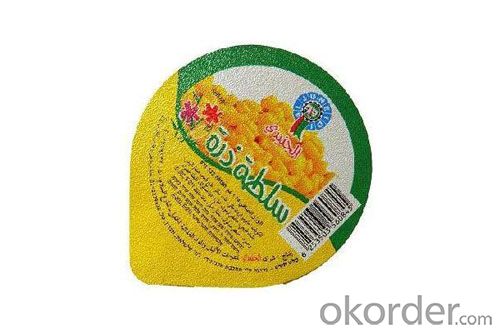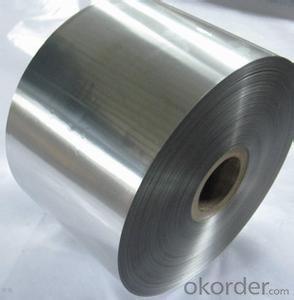Rolled Aluminum Sheets for Roofing - Aluminum Lidding Foil for Yogurt Packaging
- Loading Port:
- China main port
- Payment Terms:
- TT OR LC
- Min Order Qty:
- 3 m.t.
- Supply Capability:
- 10000 m.t./month
OKorder Service Pledge
OKorder Financial Service
You Might Also Like
Specification
1.Description of Aluminum Lidding Foil for Yogurt Packaging
*No joint-points per 1000m
*Free samples
*Waterproof and acid attacks
*Surface: With or without gloss/mat effect
*Printed: clear, fastness, non-fade in high-temperature heat seal process
2.Why you want to choose us?
We've been specialized in aluminium foil for more than ten years, we know this product very well, we know what is good, what is the market price.
3.Specification and Application of Aluminum Lidding Foil for Yogurt Packaging
Aluminum alloy no & temper: 8011-O
Width: Max width:60-1000mm;
Thickness: 24mic~60mic;
Coil inner diameter: 76mm;
Printing Color: Less than 8 colors
4. Property of Aluminum Lidding Foil for Yogurt Packaging
pure aluminum 99.9%, First class barrier property against moisture, oxygen,
light corrosion and puncturing.
Strong sealing strength, bonding strength, tear strength and excellent compression
strength.
Non-breakage, non-leakage, non-delaminating, non-poisonous, odorless ,super damp-proof function
5.Pictures of Aluminum Lidding Foil for Yogurt Packaging


6.FAQ
1) How about your company?
A world class manufacturer & supplier of aluminum coil and alloy blanks. Aluminum production base is comprised of 18 aluminum annealers, 10 coil and foil mills, 4 continuous production lines, 2 hot rolling production line and 3 prepainted lines.
Export 5000 tons per month to Asia, America and Middle East. Always do the best for our clients.
2) Can you guarantee the quality of the products?
We are responsible for the quality of materials to get a long-term cooperation with clients in a reasonable period of time and we are glad to arrange and coordinate any third party inspection for you.
3) What is the delivery time after purchase?
35 day after receiving client’s deposit or correct LC
- Q: Are aluminum sheets suitable for food processing equipment?
- Yes, aluminum sheets are suitable for food processing equipment. Aluminum is a widely used material in the food processing industry due to its excellent properties. It is corrosion-resistant, lightweight, and has good thermal conductivity, making it ideal for applications where hygiene and efficient heat transfer are crucial. Additionally, aluminum is non-toxic and does not react with food, ensuring that it does not affect the taste or quality of the processed products. Overall, aluminum sheets are a popular choice for food processing equipment as they meet the necessary safety and performance requirements.
- Q: Can the aluminum sheets be used for manufacturing chemical storage tanks?
- Yes, aluminum sheets can be used for manufacturing chemical storage tanks. Aluminum is a versatile material that offers several advantages for this purpose. It is lightweight, corrosion-resistant, and has high strength-to-weight ratio. These properties make it suitable for storing various chemicals safely. Additionally, aluminum can be easily formed into different shapes and sizes, allowing for customization of storage tanks to meet specific requirements. However, it is important to consider the type and concentration of chemicals being stored, as some chemicals may react with aluminum. In such cases, appropriate coatings or linings may be necessary to prevent any chemical reactions.
- Q: As for cast aluminum sheet or wrought one, which one has faster heat conduction?
- 1,duralumin: it's the alloy of aluminum, copper, magnesium, manganese and other metals. it's suitable for compacting by rolling, and it has a higher strength and hardness than common aluminum products. 2, aluminum: it contains many inpurities, is crisp and easy to be smashed.cast aluminum usually is secondary aluminum, and it is produced by remelting the collected old aluminum pots and spoons.3, wrought aluminum: it contains 98% aluminum and 2% or more inpurities, and is comparatively pure aluminum. its soft priority makes it suitable for being pressed into various shapes, aluminum pots,aluminum lunch box,aluminum sheets,aluminum wires,aluminum pipes are all made by wrought aluminum.you will know their defferences from their definition.
- Q: What are the different bending methods for aluminum sheets?
- There are several different bending methods for aluminum sheets, each with its own advantages and limitations. Some of the commonly used bending methods for aluminum sheets include: 1. Air Bending: This method involves using a punch and die to create a bend in the aluminum sheet without directly touching it. Compressed air is used to apply force on the sheet, resulting in the desired bend. Air bending is a versatile method that allows for a variety of bend angles and radii. 2. Bottom Bending: In this method, the aluminum sheet is clamped between a V-shaped die and a flat die. A punch is then used to press the sheet into the V-shaped die, creating the desired bend. Bottom bending is suitable for creating sharp bends with small radii. 3. Coining: Coined bends are created by applying high pressure to the aluminum sheet between a punch and a die. This method produces precise, crisp bends with minimal springback. However, it requires specialized equipment and is typically used for high-volume production. 4. Roll Bending: Roll bending involves passing the aluminum sheet between a set of rollers to gradually bend it into the desired shape. This method is commonly used for creating cylindrical or conical shapes. Roll bending can achieve large radii and is suitable for thicker aluminum sheets. 5. Press Brake Bending: Press brake bending is a common method that uses a hydraulic or mechanical press brake to create bends in aluminum sheets. The sheet is clamped between a punch and a die, and the press brake applies force to create the bend. Press brake bending offers flexibility in terms of bend angles and radii. It is important to note that the choice of bending method depends on various factors such as the desired bend angle, radius, material thickness, and the specific requirements of the application.
- Q: Are aluminum sheets easy to work with?
- Aluminum sheets, in general, prove to be easily manageable. Being a light and flexible metal, aluminum allows for easier cutting, shaping, and manipulation compared to its counterparts. It boasts the ability to be effortlessly bent, formed, and welded, granting access to a variety of fabrication methods. Furthermore, aluminum sheets exhibit excellent resistance to corrosion, which enhances their user-friendliness. Whether the goal is constructing lightweight structures, fabricating components, or crafting intricate designs, aluminum sheets offer versatility and convenience across numerous applications.
- Q: This question asks about the various types of coatings that can be applied to aluminum sheets.
- <p>Aluminum sheets can be coated with various materials to enhance their properties such as corrosion resistance, appearance, and durability. Some common types of coatings include: 1. Anodizing, which creates a protective oxide layer on the surface. 2. Powder coating, a dry coating that is electrostatically applied and then cured at high temperatures. 3. Paint coating, which can be either liquid or powder-based and provides a decorative and protective layer. 4. Vinyl coating, which is a plastic coating applied for a smooth, matte finish. 5. Electrolytic coating, which involves depositing a thin layer of metal onto the aluminum surface. 6. Hot-dip coating, where aluminum is coated with a layer of zinc or other metals by dipping it into a molten bath. Each type of coating serves different purposes and has unique characteristics.</p>
- Q: What are the different methods of surface etching aluminum sheets?
- There are several methods of surface etching aluminum sheets, including chemical etching, electrochemical etching, mechanical etching, and laser etching. Chemical etching involves the use of corrosive chemicals to selectively remove the surface material, creating a desired pattern or design. Electrochemical etching uses an electrical current to dissolve the surface of the aluminum sheet, also creating a pattern. Mechanical etching involves physically abrading the surface using tools or abrasive materials. Laser etching utilizes a high-powered laser beam to selectively remove the aluminum material, creating precise and detailed patterns.
- Q: Are the aluminum sheets suitable for manufacturing heat exchanger tubes?
- Yes, aluminum sheets are suitable for manufacturing heat exchanger tubes. Aluminum has excellent thermal conductivity, corrosion resistance, and is lightweight, making it an ideal material for heat transfer applications.
- Q: Are aluminum sheets suitable for use as materials for windows and doors?
- <p>Yes, aluminum sheets can be used for windows and doors. They are known for their durability, low maintenance, and resistance to corrosion and weathering. Aluminum windows and doors are energy-efficient, lightweight, and offer excellent security. They can also be easily customized in terms of size and design, and are often used in modern architecture for both residential and commercial buildings.</p>
- Q: a dream I had where the carbon element was extracted from aluminum and ploished it became transparent, it was bendable and you could puncher it with out breaking it ?
- Aluminium is an element! Elements are pure substances, therefore aluminium doesn't contain any carbon. What do you mean?
Send your message to us
Rolled Aluminum Sheets for Roofing - Aluminum Lidding Foil for Yogurt Packaging
- Loading Port:
- China main port
- Payment Terms:
- TT OR LC
- Min Order Qty:
- 3 m.t.
- Supply Capability:
- 10000 m.t./month
OKorder Service Pledge
OKorder Financial Service
Similar products
Hot products
Hot Searches
Related keywords


























